| ||||||||||||||||||||||||||
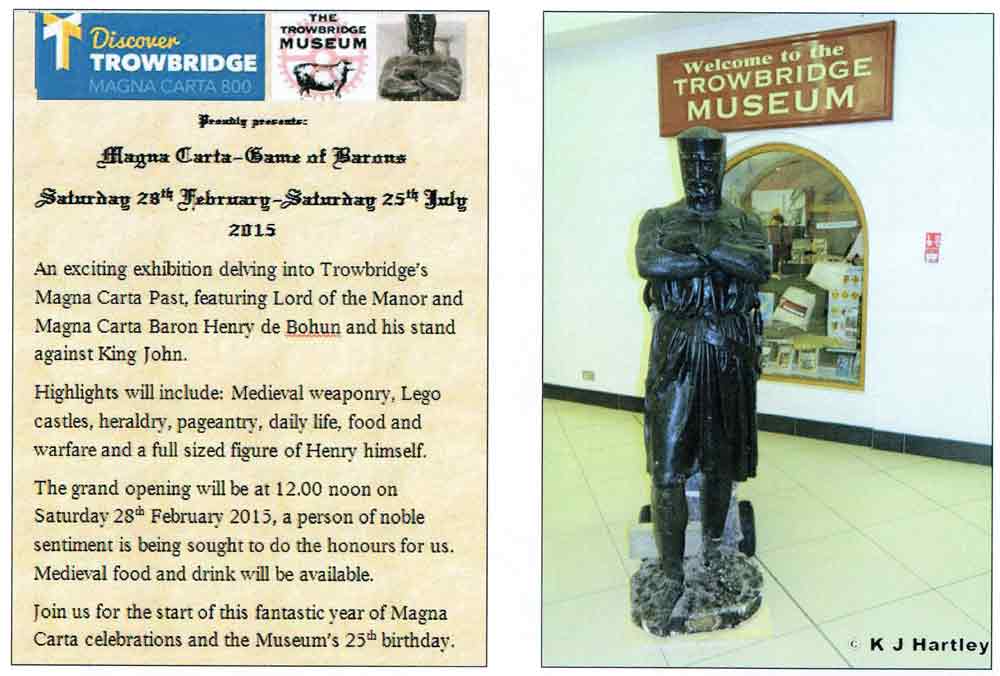 |
To celebrate the 800 year anniversary of the signing of the Magna Carta and Trowbridge's unique Magna Carta heritage, Canterbury Museums Service has loaned Trowbridge Museum an impressive Henry de Bohun maquette. Henry de Bohun was elected to be one of the twenty five barons to enforce Magna Carta.
Henry arrived safely at the Museum on Monday 12th January 2015 and looks very impressive as he stares out at prospective visitors. His inclusion among those rebel barons portrayed in bronze in the House of Lords (page 11), the only one from the West of England, confirms his importance in the struggle to ensure that even the king is not above the law. The plaster maquette was used to cast Henry's fine bronze statue.
Thomas Thornycroft was chosen to sculpt the statue of Henry, Earl of Hereford, and Lord of the manor of Trowbridge. Thornycroft is perhaps much better known for his iconic monumental representation of another famous rebel, Queen Boudicca, together with her Daughters at Victoria Embankment, by Westminster Bridge, London.
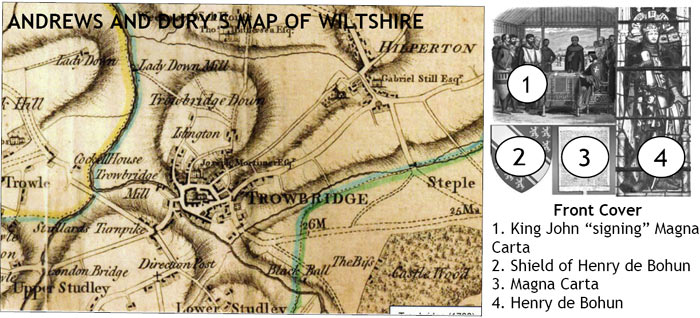 |
Contents
Click on the item to go to the article. |
Editorial CommentThe Magna Carta features heavily in this issue, and we include notices about the
conference being held in the Civic Centre and the special exhibitions etc that are being organised by the Museum. |
Forthcoming Events
| 2015 | ||
| Date and Time | Event | Venue or Meeting Point |
| Tuesday 21st April 19.00 |
Guided Tour of Wiltshire & Swindon Heritage Centre | Meet at the Heritage Centre at 19:00. |
| Tuesday 26th May 19.00 |
A guided walk around Rode led by Peter Harris. | Meet at St Lawrence Church, Rode. BA11 6PW 19:00. |
| Tuesday 30th June 18:45 |
Guided Walk around Corsham led by Corsham Civic Society | Meet at St Bartholomew's Church, Church Street, Corsham, SN13 0BS at 18:45. |
FROM THE CHAIRMAN |
Readers can’t have failed to see the work to the roof of County Hall. It is surprising when one considers that it is only a few years since the roof was completely renewed.
At the time it seemed strange that the whole roof should be replaced when as a rule it is only a very small percentage of defective tiles that need to be renewed.
I am told that it is being re-roofed again because some the new stone tiles were beginning to break up and there was a danger of the stone falling onto pedestrians. Unfortunately, English Heritage didn’t consider County Hall worthy of listing which means that the County Property Department can do as they please with the roof and the Conservation Officers have no power to stop the stone tiles being replaced by concrete ones which I understand is what is going to happen.
This has happened before. Readers may remember that the owner of The Hall in Bradford, Alex Moulton, was allowed to replace his stone tiled roof with concrete tiles. His building was listed which says much about the planners of the day and holds out little hope of ever seeing a stone tiled roof on County Hall again.
Planning Matters |
Readers may be cheered to learn that another step in the rejuvenation of Trowbridge is being taken. Permission has been granted for environmental improvement works to the site of the former Gas Works, Riverway, to enable the site to be used for redevelopment in the future.
Reason to be cheerful number two is that the owners of South Rodwell Hall have been refused permission to erect a detached four bedroomed chalet style dwelling, because “The erection of a new dwelling in the position proposed would erode (Rodwell Hall's) spacious setting and would, by reason of this and its very close proximity to Rodwell Hall cause substantial harm to the setting ... as well as interrupting and substantially harming the relationship between Rodwell Hall and the Lodge. There would be no public benefit to outweigh the substantial harm to the significance of these two designated heritage assets”. The reasoning here is very similar to that used in the Civic Society's letter arguing against the application and we are happy to think that our pleas did not fall on deaf ears.
The Society also wrote a response to Gough's application for new signage and a replacement entrance door. We objected to the signage because “we feel that the fascia sign would be over intrusive, detracting from the visual character of the street scene in this historic area” and the new door because “the replacement of the present wooden door with a fully glazed door would ... have an impact on the building's entrance, which we feel would be detrimental to the overall street scene”. Sadly, despite our comments, the proposed new door has been given planning permission.
It is reassuring that planning officers are giving careful, critical consideration to applications and not just nodding them through.
A more heartening piece of news was that the Lion and Fiddle public house has been refused permission to construct two new dwellings within the grounds, because the plot “would be entirely located in the open countryside outside the village policy limits defined for Hilperton in the West Wiltshire District Plan”. And because “the application fails to fully consider the impact upon tree preservation orders and other trees on the site”.
We looked carefully at an application from the owners of The Coach House in Church Street, Hilperton, regarding permission for “extension and alteration to create a separate dwelling”. Despite the fact that this is a listed building, we are not considering making an objection because we are satisfied that they seem to have addressed traffic concerns and are matching style and materials.
The most exciting piece of news this time is that an application has been made for the former Peter Black Toiletries Factory, Cradle Bridge. The proposed development consists of the “demolition of existing buildings and development of four retail units with associated car parking, highway works and landscaping”. We are still considering our response at the moment, as there is a great deal of associated documentation to be read and assessed
Don't forget that you can
find out more and make comments on the Society's web site.
Magna Carta |
This year sees the 800th anniversary of the signing of Magna Carta (Great Charter) in 1215. Wiltshire and Trowbridge in particular have a unique place in its history. Salisbury Cathedral still has an original copy of the charter and Trowbridge was a so-called Baron Town, that is, one of the barons who rebelled basically owned Trowbridge. The only other Baron Town in the West is the village of Curry Mallet in Somerset. Also, until 1945, Lacock Abbey held a copy of the 1225 Magna Carta which is now looked after by the British Museum. The original Magna Carta was a charter issued by King John at Runnymede on 15th June 1215. Its purpose was to make peace between a group of rebel barons who were unhappy with the King's rule. It promised protection of church rights, protection for the barons from illegal imprisonment, access to swift justice and limitations on feudal payments to the Crown. It also focused on the rights of free men, which really meant the barons and not the serfs or other unfree men. A council of 25 barons was set up to implement this. It was a kind of peace treaty. One of these barons was Henry de Bohun, Earl of Hereford. One reason he rebelled against the king was that some of lands and property was taken away from by John and given to John’s half brother, William Longspee. Trowbridge had been the “caput” or head quarters of Henry and he had spent years developing the town, modernising the castle, obtaining possibly the earliest Market Charter in Wiltshire and had built the first St James church. (There is an image of him in the church holding a copy of the charter). By virtue of his involvement on the rebel side in 1215 he secured the restoration of the territorial lordship, although not of the castle, of Trowbridge. Letters ordering the estate's restitution to him were among the first to be issued in 1215 in execution of the Charter. The dispute continued to splutter on, however, and a final settlement was not reached until 1229, when Edward of Salisbury's estates were divided equally between the claimants, the castle and manor of Trowbridge itself going to the Countess Ela, Longespée's widow!
The charter, with various changes, was reissued in 1216 and at the end of the war in 1217 another version formed part of the peace treaty, where it first acquired the name Magna Carta, referring to its considerable size. In 1225 a great council approved a tax of £40,000 to send an army to France to get back Henry's provinces, Poitou and Gascony, which had been invaded by Louis VIII. The barons agreed to support Henry if he agreed to reissue the 1217 version of the Magna Carta which he did of his own “spontaneous and free will”. In 1253 Henry confirmed the charters (including a Charter of the Forest) in exchange for fresh taxation. When Edward I became king he re-issued the charter in 1297, again in return for a new tax and it is this version which remains in statute today, although most of the articles have now been repealed. The charter influenced many other countries when they were forming constitutions, especially in America, though historians have shown that the original 1215 charter was about the relationship between the barons and the king rather than the rights of ordinary people. |
| Corporate Member: | The Trowbridge Museum |
Andrews and Dury's Map of Wiltshire, 1773 |
Local historians working on Wiltshire have good cause to remember the names of John Andrews and Andrew Dury with gratitude and respect. Their map (page 2), published in 18 large sheets at about two inches to the
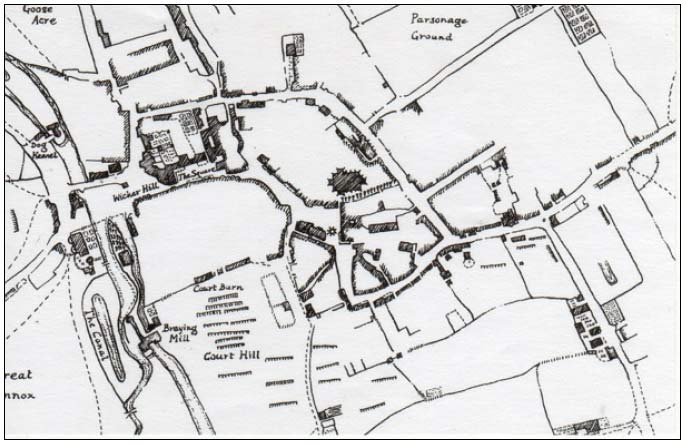 mile, is the first detailed survey of our county. It pre-dates the Ordnance Survey one-inch sheets by some forty years, and while we wish it had been twenty years earlier to recapture the roads before many turnpike changes, it gives us an unrivalled picture of north and west Wiltshire before Parliamentary enclosures had done away with the greens and commons which were still so extensive in 1773. Much of the detail it provides is unique, especially for places which have no early map. The layout of the pleasure grounds and lakes shown at Rood Ashton was swept away by later park improvements before the West Ashton Tithe Map was made. Another park feature shown is the radiating avenues still standing at Cutteridge, though the mansion has been gone for two centuries. At Hilperton, another place with no early map, we see a pond in front of the Lion and Fiddle and from it a stream running along the middle of the road.
mile, is the first detailed survey of our county. It pre-dates the Ordnance Survey one-inch sheets by some forty years, and while we wish it had been twenty years earlier to recapture the roads before many turnpike changes, it gives us an unrivalled picture of north and west Wiltshire before Parliamentary enclosures had done away with the greens and commons which were still so extensive in 1773. Much of the detail it provides is unique, especially for places which have no early map. The layout of the pleasure grounds and lakes shown at Rood Ashton was swept away by later park improvements before the West Ashton Tithe Map was made. Another park feature shown is the radiating avenues still standing at Cutteridge, though the mansion has been gone for two centuries. At Hilperton, another place with no early map, we see a pond in front of the Lion and Fiddle and from it a stream running along the middle of the road.
As a primary source, of course, a printed map, however good, is second best to a larger scale survey of an individual parish or estate. Thus, the local historian of Steeple Ashton has a far superior source in the superb estate map of 1760, and for Keevil there is one of 1749. 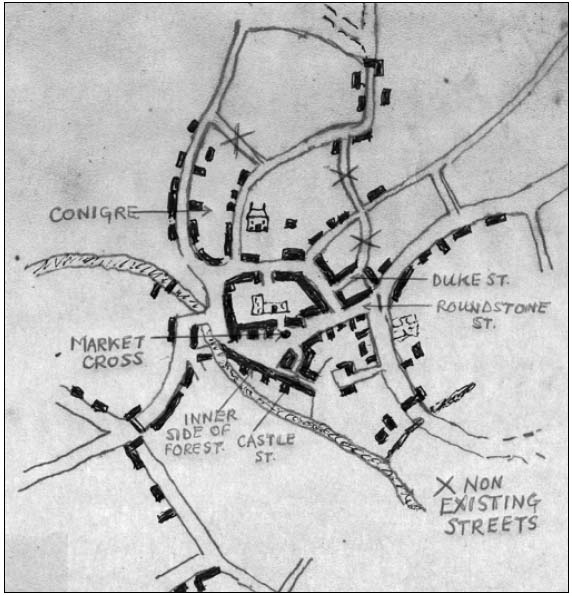 Comparison may well reveal places where the printed map appears inadequate or wrong. A good example is East Town where I am writing these words. The lanes leading to it were in place much as now by 1773, yet the map shows only one, not corresponding exactly to any in particular, leading from the east. It looks rather as though somebody said that there was such a place over there in the fields, and so it was put in without a visit. Perhaps it was the end of a long day!
Comparison may well reveal places where the printed map appears inadequate or wrong. A good example is East Town where I am writing these words. The lanes leading to it were in place much as now by 1773, yet the map shows only one, not corresponding exactly to any in particular, leading from the east. It looks rather as though somebody said that there was such a place over there in the fields, and so it was put in without a visit. Perhaps it was the end of a long day!
This leads me to the reason for this note - one of the map's poorest efforts is our own town. The surveyors seem to have been completely baffled by its plan of two parallel quarter-circle streets, Fore Street and Back Street. We know that this plan is unchanged from the Middle Ages, but if anyone really needs confirmation that the 1773 map is wrong, we have two almost contemporary maps showing the plan as now. One is the partly finished sketch map of the 1770s (Book of Trowbridge, p. 102), the centre part of which is reproduced here, the other the 1780 map at Belvoir Castle.
Andrews and Dury show the outer curve, from the present Post Office to the bottom of Back Street, more or less correctly, but completely miss the sharp right turn by the Town Hall, so that it looks as though Roundstone Street, Silver Street, Fore Street, and Wicker Hill are all in one line. I hope the drawing will make this clear. They also show roads which did not exist at the time, and fail to show the ranks of buildings in the Conigre and the Brick Plat.
If the town centre had ever looked like they depict it — which it certainly never did - it would not have justified the old jingle:
Trowbridge steeple, long and little,
Narrow streets and dirty people.
April 2015 Civic Centre, Trowbridge 9:30am - 4:30pm
King John and Magna Carta England - The reality behind the myth
Magna Carta 800th Anniversary Conference
SPEAKERS:
| King John and the Road to Magna Carta | Sean McGlynn |
| Life in King John-s England | Martyn Whittock |
| Writing Historical Fiction Set in the Era of Magna Carta | Dr Cath Hanley |
| The Greatest Knight: William Marshal and Chivalry | Dr Matt Bennett |
| King John's Women | Dr Elena Woodacre |
| A Magna Carta Baron: Henry de Bohun | Andy Milroy |
| Trowbridge Castle | Ken Rogers |
Sean McGlynn
Sean McGlynn is a regular contributor to History Today, BBC History, English Historical Review, History and other journals. He lectures in History at The Open University and the University of Plymouth at Strode College where he teaches a module on King John. He has published widely on King John and is academic advisor to Salisbury Cathedral's Magna Carta 800 projects, writing the cathedral's official Magna Carta guide. He is a Fellow of the Royal Historical Society.
Martyn Whittock
Martin Whittock specialises in local history and has written numerous textbooks for the educational market. He has been a consultant for the BBC, English Heritage and the National Trust and has written for Medieval History and archaeological journals. He teaches locally.
Catherine Hanley (who writes under the name C B Hanley)
Dr Cath Hanley originally comes from Perth in West Australia and went to school in St Augustine's in Trowbridge. She is a writer and researcher specialising in the Central Middle Ages. She writes historical fiction under the name of C B Hanley. Her successful series of novels is set in the Magna Carta period.
Matthew Bennett
Dr Matt Bennett is a leading authority on medieval warfare and chivalry, on which he has written many learned articles and edited a number of authoritative reference works. He retired as Senior Lecturer at The Royal Military Academy, Sandhurst in 2014.
Elena Woodacre
Dr Elena Woodacre is an American academic who lectures in Early Modern European History at the University of Winchester, specialising in medieval and early modern queenship. She gained her PhD at Bath Spa University.
Ken Rogers
Former Wiltshire County Archivist who has written widely on Trowbridge's local history and on the town's castle.
His knowledge is based on a life time of research.
Andy Milroy
A published author, his primary medieval research has been studies of the Trowbridge Baron Henry de Bohun and the de Bohun family which will be published in 2015.
Letters to the Editor |
Dear Editor
We found your article on Edward Thomas fascinating and at the time of writing (October) most poignant.
We were saddened to hear of the death of that wonderful friend of the town, the Revd. Christopher Brown, our ex-rector. In 2013 Chris officiated at the funeral of Pete Foreman, a close friend, bird watcher and railway buff. Later, Julianne Foreman organised a special steam train trip on the West Somerset railway and Pete's ashes were scattered from the train. At the appropriate spot Chris read Thomas's poem Addlestrop as he thought it so beautifully expressed Pete's interests.
John and Kay Austin
Dear Editor
I am a little worried. The Spring 2014 newsletter, under Planning Matters, says that listed building consent has been given to convert 64 Fore Street into residential use. For Lloyds Bank to close will be a great loss to Trowbridge or is it not 64 Fore Street which has been given consent?
Yours sincerely
Roger Newman
(Oops! It was 65 Fore Street. A typing error or perhaps we were just testing in the manner of Captain
Mainwearing and wondered who would notice the deliberate mistake. Ed)
Rodwell Hall |
(Rodwell Hall was built on Victoria Road in Trowbridge in 1859 - the road itself was only laid out in 1858. The Hall was built for Jesse Gouldsmith, who was one of the largest cloth manufacturers in the town. It was named after a house near Weymouth that belonged to the Devenish family, to whom the Gouldsmiths were related.)
Situated on Victoria Road, Rodwell Hall was listed Grade II in 1976, and dates from the mid 19th century, according to Julian Orbach, who (in his ‘Victorian Architecture in Britain’) picks it out as one of the two most notable large houses built in this area for prosperous ‘cloth magnates’. The Wiltshire Buildings Record publication ‘Architects and Building Craftsmen with Work in Wiltshire’ gives the date as 1859, and the architects as Manners and Gill of Bath - prominent local architects who were responsible for many familiar buildings in Bath and in local towns. George Phillips Manners was the architect for Christ Church in Bradford on Avon (1841), with its distinctive spire supported by flying buttresses, as Pevsner records. In Bath, Manners 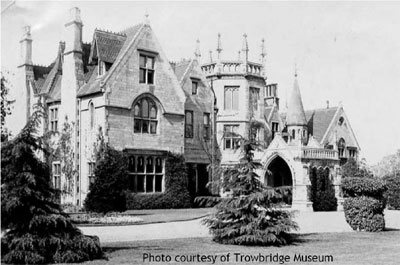 was City Architect from 1823 to 1862, building St Michael (1834-37) on Broad Street, sited prominently at the sharply angled corner with Walcot Street. Michael Forsythe considers this to be ‘Manners' most notable work’, its ‘splendid tower’ prominent with its ‘huge group of three stepped lancets, buttresses and corbel tables based on the East end of Salisbury Cathedral. At the top, the tall octagonal open lantern resembles German Gothic (cf. Freiburg Cathedral).’ Later, in partnership with C.E. Gill (1845 to 1866), Manners produced buildings such as the Bluecoat School (1859-60) on Upper Borough Walls, designed in Jacobean style, with ‘an eclectic Flemish flavour’ and ‘witty’ references to the building it replaced (according to Forsythe). Manners and Gill were also responsible for the restoration of St James’s church, Trowbridge, in 1847-48, which was (according to the English Heritage listing) ‘extensively and accurately’ carried out.
was City Architect from 1823 to 1862, building St Michael (1834-37) on Broad Street, sited prominently at the sharply angled corner with Walcot Street. Michael Forsythe considers this to be ‘Manners' most notable work’, its ‘splendid tower’ prominent with its ‘huge group of three stepped lancets, buttresses and corbel tables based on the East end of Salisbury Cathedral. At the top, the tall octagonal open lantern resembles German Gothic (cf. Freiburg Cathedral).’ Later, in partnership with C.E. Gill (1845 to 1866), Manners produced buildings such as the Bluecoat School (1859-60) on Upper Borough Walls, designed in Jacobean style, with ‘an eclectic Flemish flavour’ and ‘witty’ references to the building it replaced (according to Forsythe). Manners and Gill were also responsible for the restoration of St James’s church, Trowbridge, in 1847-48, which was (according to the English Heritage listing) ‘extensively and accurately’ carried out.
Rodwell Hall, then, is a building of some significance, as it is by architects of note. According to the
English Heritage listing, the mansion was built for Mr Hayward, and the listing mentions the ‘south front
(which) has (a) central shaped gable with monogram “CH%rdquo; with a lion above.&rsquo However, this is disputed by
Ian Walker in a note on the listing dated 15th November 2010. Walker's research, he claims, ‘suggests that
the house was built for Mr Jesse Gouldsmith, not Mr Hayward. There is a cartouche on a gable on the south west elevation with the monogram “JHG” which supports this. Gouldsmith and Hayward were business partners at Salter's Mill in Trowbridge, but did not, as far as I can tell, live together.’
The description in the English Heritage listing identifies the style as ‘Gothic Renaissance’, an appropriate choice for a gentleman's residence, according to J. Mordaunt Crook. Although in ‘The Rise of the Nouveaux Riches: Style and Status in Victorian and Edwardian Architecture’, he is mainly concerned with millionaire members of the nouveaux riches and their country houses, the distinction he draws between old money and new money may be informative in regard to Rodwell Hall - even though the full picture he sketches out is complex. Fundamentally, Mordaunt Crook observes, the Gothic style was favoured by millionaire old families, such as the 3rd Marquess of Bute who employed William Burgess at Cardiff Castle (1866 onwards). Such a choice of style is meant to display &#lsquo;the trappings of antiquity’ (Mordaunt Crook), and would seem
to be a natural choice for parvenus wishing to assert the position in society that had been made possible by their new wealth. However, by the late 1850s, ‘Gothic - thanks to the Ecclesiologists - (was beginning to seem) too Anglican’ (Mordaunt Crook) and self-made men, often with roots in non-conformism, would be looking to show their status in other ways than the pure Gothic Revival style. Mordaunt Crook suggests that, certainly at the level of the very rich, ‘some form of Classicism’ was a popular choice, for ‘Classicism was urban, and new money was money made in town.’ Renaissance or Neo-Classical forms were, he points out, ‘the Establishment style in England’, and so the choice for Rodwell Hall of the style described by English Heritage as ‘Gothic Renaissance’ is interesting, since it suggests an awareness on the part of owner and architect of what would be fashionably appropriate for a cloth magnate of some wealth. The ‘polygonal French Renaissance type staircase tower’ mentioned in the listing reinforces this impression of
sensitivity to style, as it anticipates the porte cochere which was added later (1878), when the ‘overtones of opulence’ carried by the French Renaissance manner were becoming so fashionable that ‘no newlyminted millionaire would have settled for anything less’ (Mordaunt Crook). Granted, the owner of Rodwell Hall would not have been in the millionaire bracket, but seemed to have been aware of what persons of that status were choosing to build.
However, times and societies change. These days, Rodwell Hall is divided into separate units, and parts of its garden have been built on. Since the government's National Planning Policy Framework (NPPF) was published in 2012, replacing previous guidance, the assumption has been that developers' applications should be permitted by local councils - a stance that certainly has implications for the interests of Trowbridge and its Civic Society, since there may well be cases where there is a conflict between issues regarding development or conservation, although one section of the NPPF does give guidance on such issues.
A recent application for development (14/10577/FUL) in the garden of Rodwell Hall is such a case, and the Society lodged an objection as follows:
“On behalf of Trowbridge Civic Society, I should like to lodge an objection to this proposed development, which is within the curtilage of a listed building. The National Planning Policy Framework (2012) stresses (Para 126) the importance of local planning authorities recognising that ‘heritage assets are an irreplaceable resource’ and care should therefore be exercised in judging any proposal, including ‘any contribution made by their setting’ (Para 128). We consider, especially in the light of previous developments in the vicinity of the building, that the proposals, far from ‘making a positive contribution to local character and distinctiveness’ (Para 131), would detract considerably from the setting of Rodwell Hall. Para 132 states that the significance of an asset (such as Rodwell Hall) ‘can be harmed or lost through alteration or destruction of the heritage asset or development within its setting (our italics). As heritage assets are irreplaceable, any harm or loss should require clear and convincing justification.’ There would certainly be ‘substantial harm&rsquo (Para 132) to the setting of Rodwell Hall, and the advice given in Paragraph 133 states ‘Where a proposed development will lead to substantial harm to or total loss of significance of a designated heritage asset, local planning authorities should refuse consent, unless it can be demonstrated that the substantial harm or loss is necessary to achieve substantial public benefits that outweigh that harm or loss.’ We see, however, no public benefits arising from this proposal, apart from a very marginal provision of accommodation in the local area.
We are aware, certainly, that ‘Local planning authorities should look for opportunities for new development within Conservation Areas ... and within the setting of heritage assets to enhance or better reveal their significance’ (Para 137). However, although Paragraph 137 continues: ‘Proposals that preserve those elements of the setting that make a positive contribution to or better reveal the significance of the asset should be treated favourably,’ we consider that there is no positive contribution made to the setting of this building (quite the reverse). Permission should therefore be refused.”
The application for development was rejected on 22nd January 2015.
Bibliography
Crook , J. Mordaunt (1999) ‘The Rise of the Nouveaux Riches: Style and Status in Victorian and Edwardian Architecture’, John Murray
Forsyth, M. (2007) ‘Pevsner Architectural Guides: Bath’, Yale University
Orbach, J. (1987) ‘Victorian Architecture in Britain’, A. and C. Black
Pevsner, N. and Cherry, B. (1975) ‘The Buildings of England: Wiltshire’, Penguin Books
Slocombe, P . ed. (1996) ‘Architects and Building Craftsmen with Work in Wiltshire&rsquo, Wiltshire Buildings Record
RECENT MEETINGS: |
Heritage Protection in the 21st Century |
On the 21st October Ian Lund a retired planning officer from Bath and North East Somerset gave a fascinating, illustrated talk about his work in the area, particularly in the city of Bath. His team had wide-ranging responsibility for the archaeology of the city, its listed buildings, the conservation area. It also had to work under the restrictions of being a UNESCO World Heritage site. He first talked about the importance of having a consistent approach to conservation, hoping to preserve the best of Bath rather than replacing it. Mistakes had obviously been made in the past, especially when dealing with the destruction during the Second World War and nowadays they had to tread a delicate balance between what developers wanted and what was best for the “look” of Bath.
Ian finished his talk with a look at some of the new developments along the riverside and there was a discussion about how they fitted in.
Trowbridge Barracks |
Neil's talk on 25th November covered the history of the site of Trowbridge Barracks from the late 18th century to 1961. The illustrated talk showed many photographs and maps of the whole area, as well as newspaper cuttings, and was a fascinating account, not just of the barracks themselves, but also of the local history of these times when it was often deemed necessary to have soldiers stationed in the area to keep the peace.
Neil finished with a query which perhaps one of our readers can solve. Was Surrey Place, one of the ranks of houses at right angles to Waterworks Road, originally built as married quarters for the officers of the barracks?
New Year Social |
The New Year Social was held on 13th January and members were encouraged to try our chairman's quiz which consisted of photographs of bits and pieces of Trowbridge. Some were very familiar, but it was difficult to remember where they had been seen, and others were out-of-the way features which we will now look out for. The food was very good and tasty as usual and accompanied by Ruth's delicious punch. Afterwards, Glyn gave a talk on Public Lighting in Trowbridge from the 18th Century and also took us through his picture quiz, Unique Trowbridge, putting out of our misery those of us who were unable to answer all the questions.
Clarence Vearncombe |
Looking through some Trowbridge family studio photographs, I came across two that were not by Houlton Bros. One is of my father and the other is of his sister Bernice (a onetime life member of the Society), his aunt Madeline Cray and his sister in law Winifred Austin. Each is inscribed “Clarence Vearncombe, Trowbridge”. According to Roger Newman's records he ran his business from the first floor of the Market Hall (now the Isaac Pitman pub) from prior to December 1917 until April 1920. Further research reveals that he was
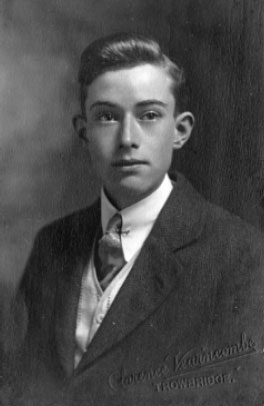 born in Bridgewater in 1893, married Florence Goodridge in Cardiff in 1916 where their son, also Clarence, was born the following year.
born in Bridgewater in 1893, married Florence Goodridge in Cardiff in 1916 where their son, also Clarence, was born the following year.
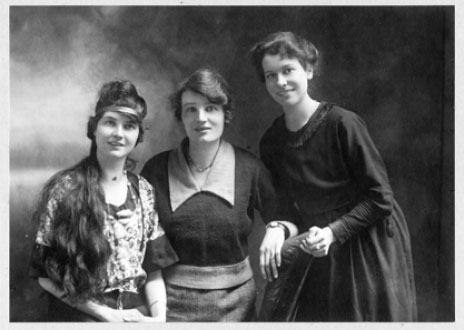 Apparently Vearncombe deserted his wife and in 1921 set sail for Natal aboard a Castle Line ship. He is thought to have had a bigamous marriage in South Africa. Florence died in Bridgewater in 1966 and their son, an army driver, was killed in Egypt in 1943. I found another Vearncombe Trowbridge image on the internet, a charming study of a young woman with a horse. I wonder if any other members have family portraits by the bigamist from Bridgewater?
Apparently Vearncombe deserted his wife and in 1921 set sail for Natal aboard a Castle Line ship. He is thought to have had a bigamous marriage in South Africa. Florence died in Bridgewater in 1966 and their son, an army driver, was killed in Egypt in 1943. I found another Vearncombe Trowbridge image on the internet, a charming study of a young woman with a horse. I wonder if any other members have family portraits by the bigamist from Bridgewater?
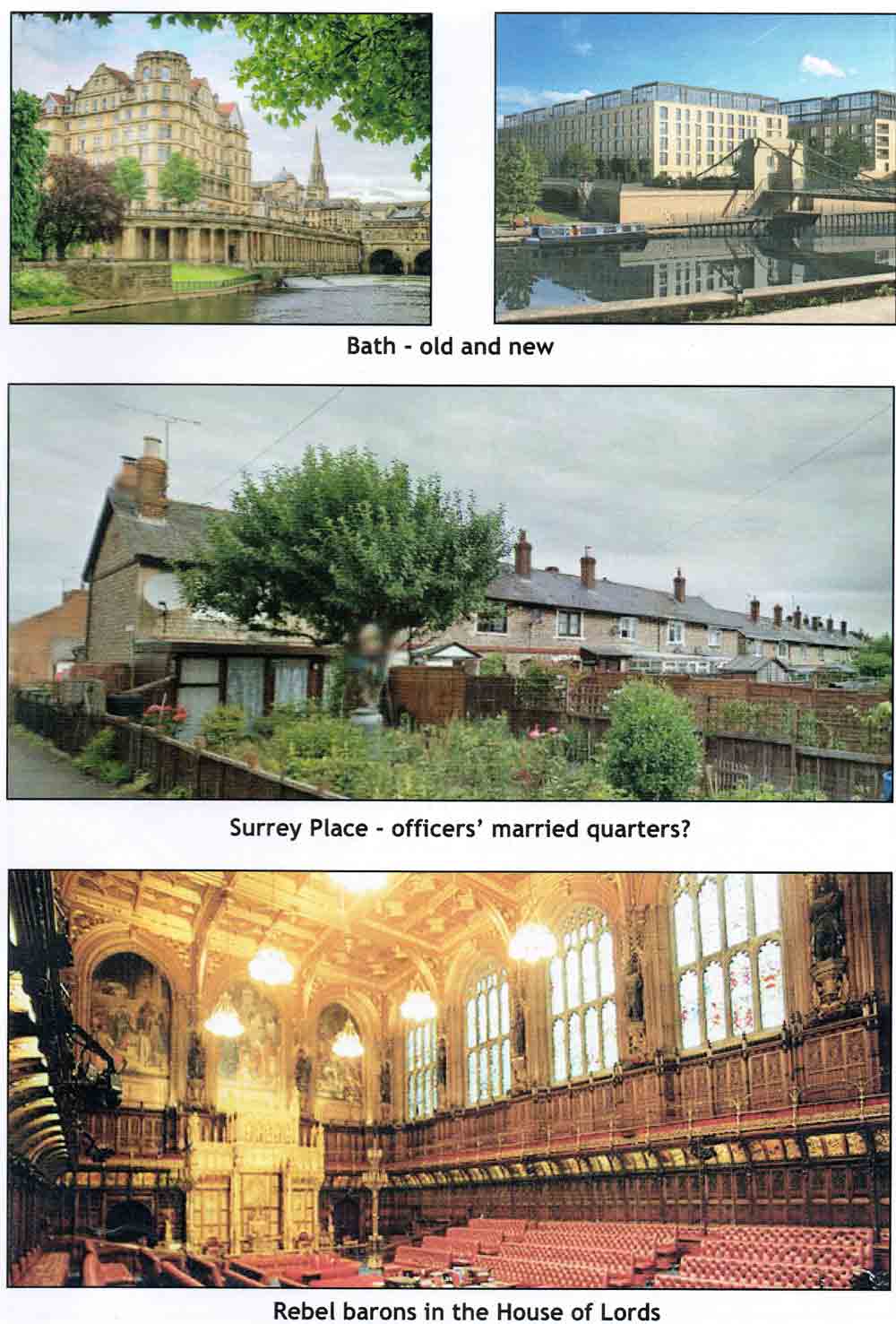
Trowbridge Connections 3 |
Edward Rennie was born in Sunderland in 1966. His family moved to Trowbridge and he attended the John of Gaunt Comprehensive School. From there he went to Trowbridge College and took the Foundation in Art and Design course. From Liverpool Polytechnic he received a First Class Degree in Fine Art, and then took his Masters Degree at the Royal College of Art. He has recently shown new painting and photography in Antwerp, Belgium. He has work in national and international collections of painting including Manchester Airport, Nomura International (London), Susan and Robert Summer Collection of British Contemporary Painting, (New York) and has had exhibitions across Great Britain, as well as Switzerland and the USA.
Edward is currently Senior Lecturer in Fine Art at De Montfort University, Leicester.
He says of his work, “I am interested in how colour can describe space - or change as it becomes
an ‘edge’ against another colour. Iridescent surface and ‘fluctuation’ of edge create an uncertainty,
which contrasts with apparent balance and order. I think it is important that a large, physical painting has elements that are also very fragile, hidden or transparent.”

Above are two new works by Edward. The painting is oil on canvas and is 100cm x 70cm. The photograph is a new venture.
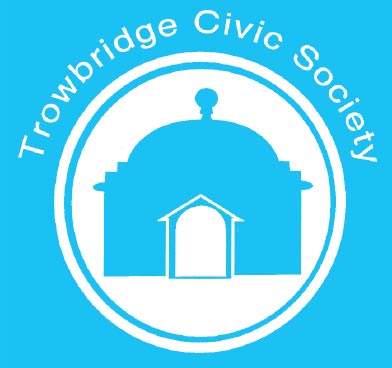
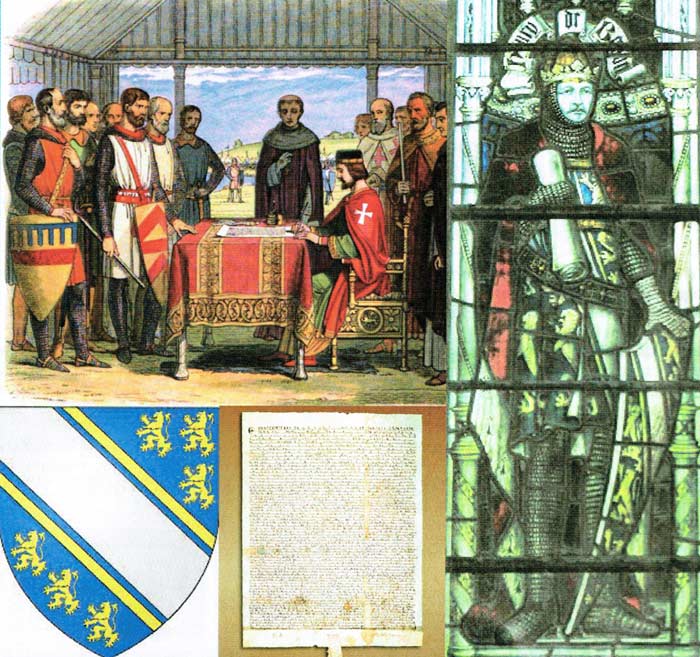
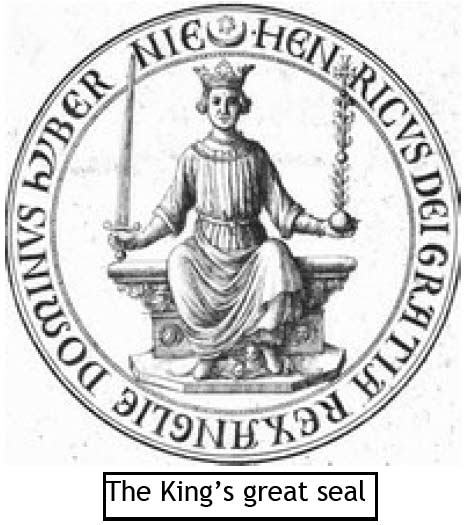 This first Magna Carta did not last long as a peace treaty.
John was supported by Pope Innocent III who annulled it. This led to the first Barons' War. John died soon after and
was succeeded by his 9 year old son, Henry III. Meanwhile the rebels had called on the French for help. The French king's son, the future Louis Vlll invaded southern England and was proclaimed “King of England&rdquo in London on the 2nd June 1216. Although he later returned to France, it is not often remembered that the last time England was “invaded” was not 1066!
This first Magna Carta did not last long as a peace treaty.
John was supported by Pope Innocent III who annulled it. This led to the first Barons' War. John died soon after and
was succeeded by his 9 year old son, Henry III. Meanwhile the rebels had called on the French for help. The French king's son, the future Louis Vlll invaded southern England and was proclaimed “King of England&rdquo in London on the 2nd June 1216. Although he later returned to France, it is not often remembered that the last time England was “invaded” was not 1066!